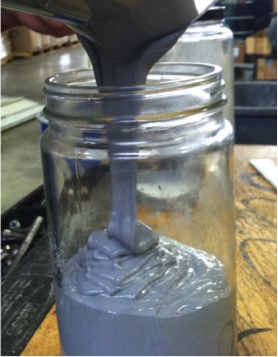Safe Hydrogen is developing knowledge of slurry properties and reactor design
Safe Hydrogen uses a slurry of Magnesium/Magnesium Hydride particles with light mineral oil as a rechargeable medium. When the slurry is discharged, the particles are magnesium and, when the slurry is charged, the particles are magnesium hydride.
The chemical equation is: Mg + H2 <--> MgH2
The two way arrow indicates that the reaction is reversible which makes the slurry rechargeable. The atomic weight of the magnesium atom is 24 and the atomic weight of the hydrogen atom is 1. The molecular weight of MgH2 is 26. Hydrogen is 2 of the 26 or 7.7% by weight. We use a 50% mineral oil and 50% MgH2 mixture for the slurry. The magnesium hydride slurry has 3.85% hydrogen by weight.

Efficient and safe storage and delivery of hydrogen is the major technical challenge of utilizing hydrogen as an alternative energy carrier.
Compressed and liquid hydrogen tanks often don't store sufficient volumes and pose safety risks. But Safe Hydrogen's metal hydride based chemical hydride and rechargeable hydride technologies offer storage efficiency and storage safety while providing the cost saving advantage of being able to use the existing fossil fuel infrastructure to deliver and store a pumpable and non-explosive hydride slurry as future "hydrogen fuels."
Cryogenically cooling hydrogen into a liquid state is a well established technology and considered the comparative benchmark for storing hydrogen. But the technology requires substantial energy to liquefy the hydrogen, includes continual "boil off" of hydrogen during storage and requires very costly storage tanks and handling.
Slurries, on the other hand, are stored at normal temperature and
pressure, can use existing low-cost "fossil fuel" tanks and pipe
lines and because they are not explosive and are flame resistant,
they do not require any specialized and costly handling procedures.
Below, we show the results of holding a blow torch on a blob of slurry.



